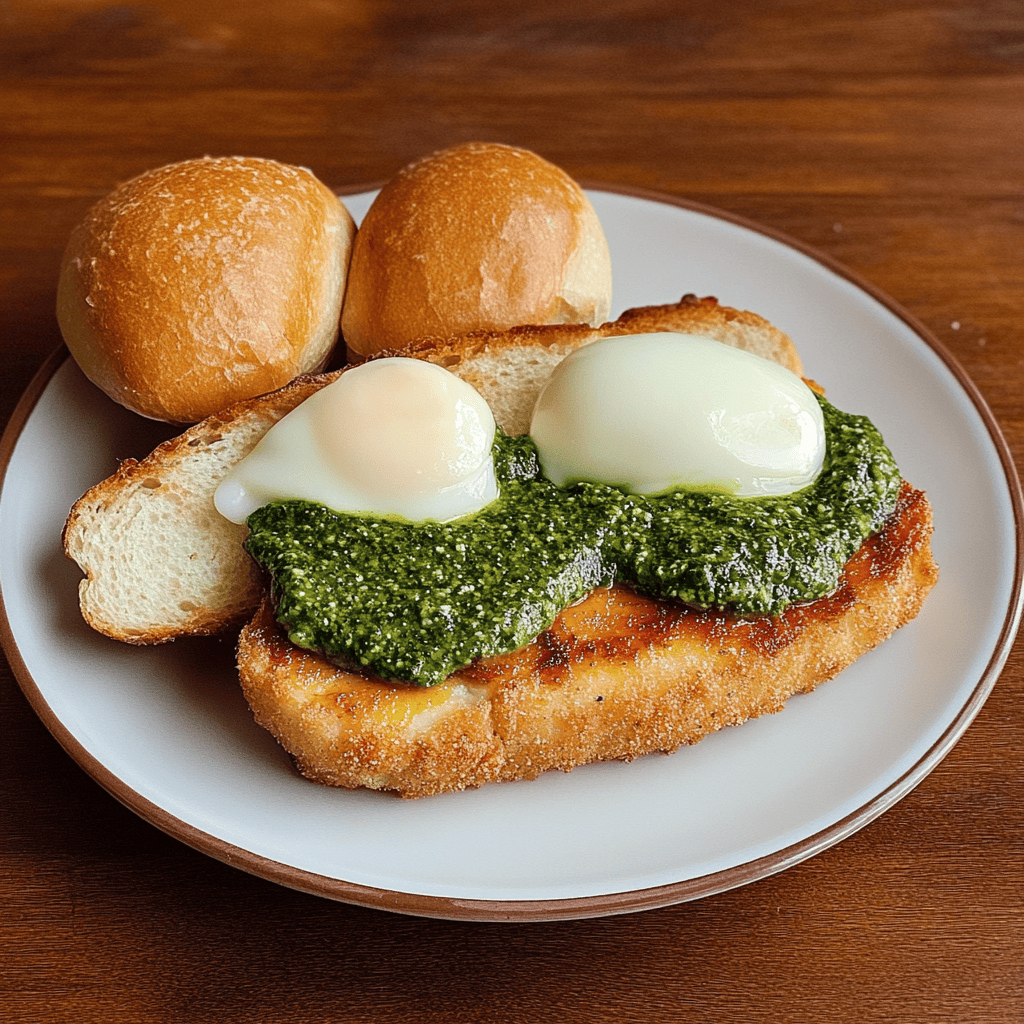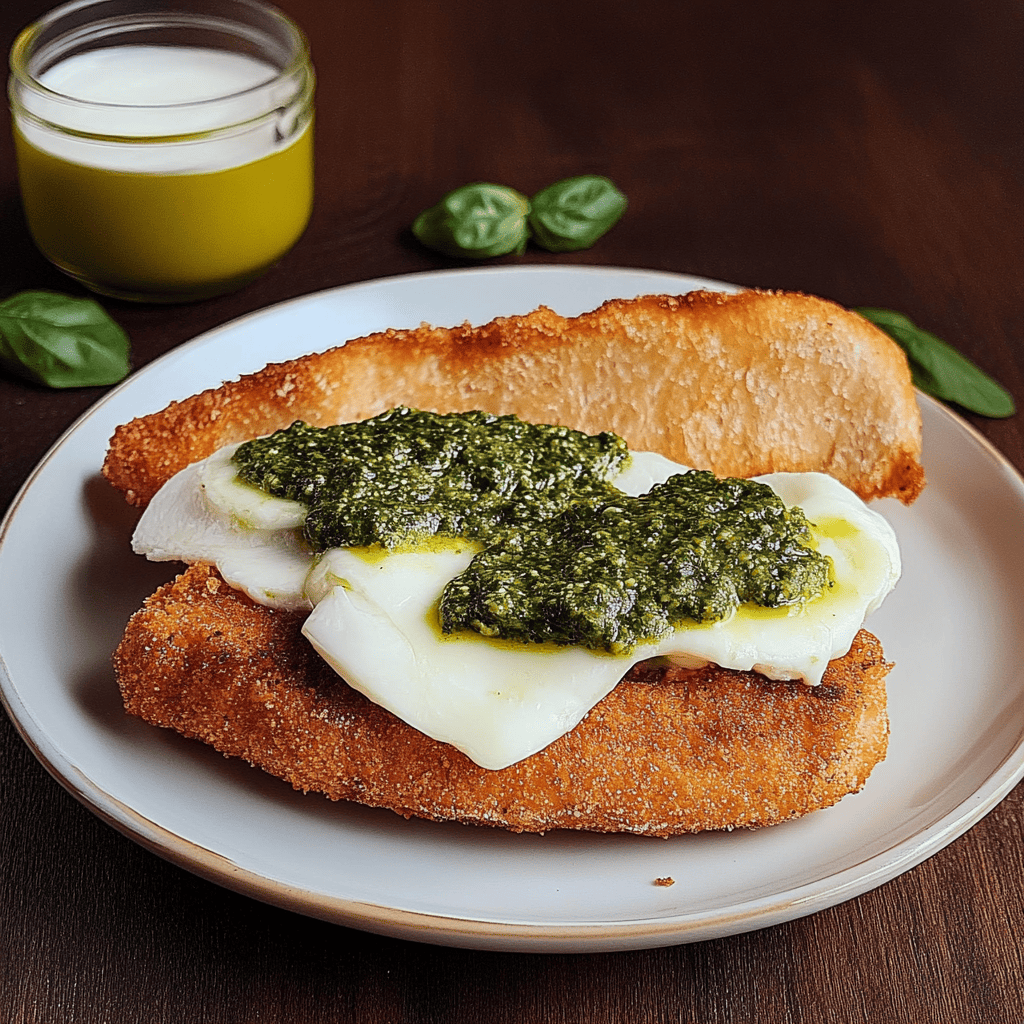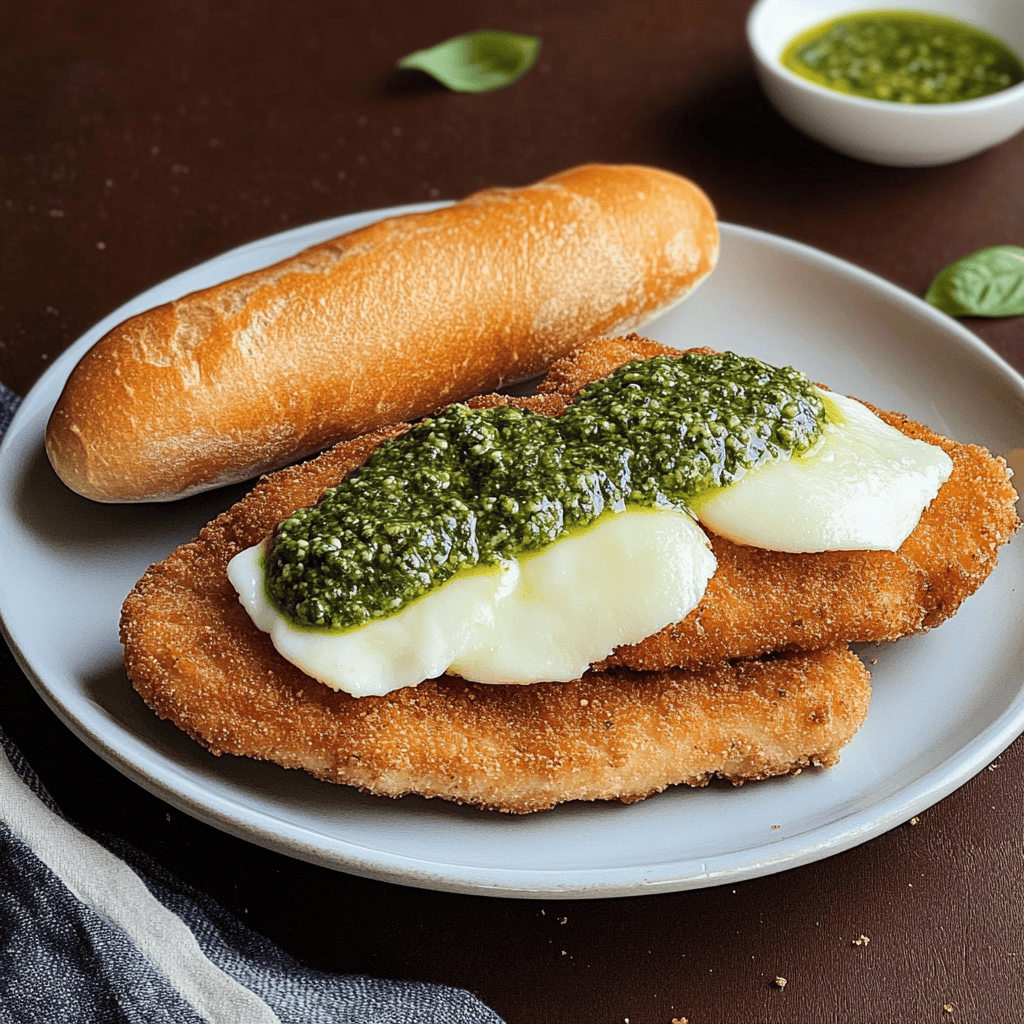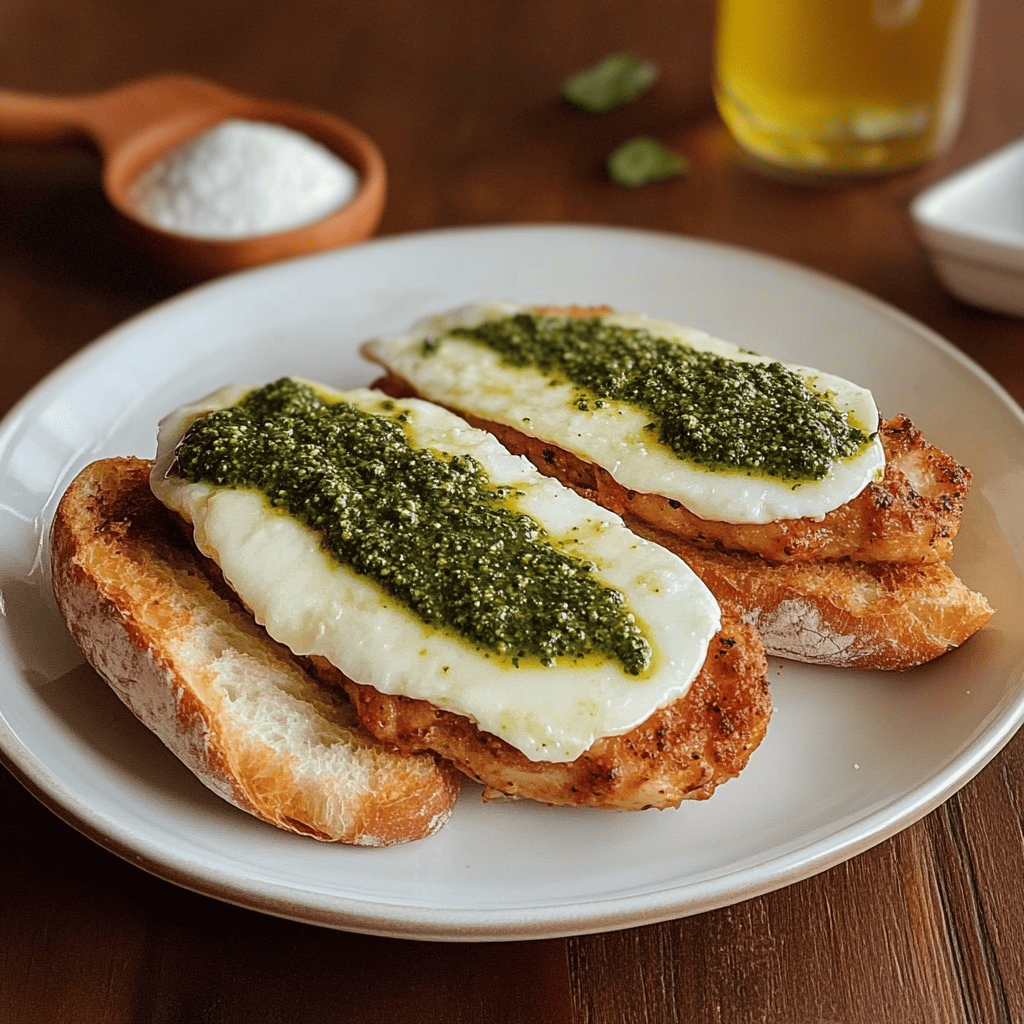Chicken Milanese with Pesto: A Reinvented Classic with Mediterranean Flavor
Introduction: An Aromatic Twist on Traditional Milanese
“Chicken Milanese with Pesto” is a delicious and aromatic twist on the classic Milanese, infusing the vibrant, herbaceous flavor of pesto directly into the breading. This dish elevates a familiar recipe to a more sophisticated culinary experience, combining the tenderness and succulence of chicken with a crispy coating bursting with the Mediterranean character of pesto. The result is a golden Milanese with an irresistible crumb and a burst of flavor from basil, pine nuts, garlic, and Parmesan cheese in every bite. Perfect for a quick weeknight meal, a special dinner, or as part of a gourmet sandwich, this Milanese with pesto promises to surprise and delight, offering a new dimension of flavor to an already beloved dish.
Detailed History: The Fusion of Italian and Latin American Culinary Traditions
Milanese has its roots in the “cotoletta alla milanese” of Milan, Italy, a breaded and fried veal cutlet. This dish traveled to Latin America with the great waves of Italian immigration in the late 19th and early 20th centuries, especially to countries like Argentina and Uruguay, where it became a mainstay of the cuisine and adopted the name “milanesa.” Over time, it was adapted to different types of meat, with chicken being one of the most popular due to its versatility and accessibility. The essence of Milanese lies in its preparation: a thin piece of meat, coated in egg and breadcrumbs, and fried until it has a golden, crispy outer layer.
Pesto, on the other hand, is an Italian sauce originating in the Liguria region, particularly Genoa. Its name comes from the Italian verb pestare , meaning “to pound” or “to grind,” referring to the original method of preparation in a mortar and pestle. The classic ingredients of pesto are fresh basil, pine nuts, garlic, Parmesan (or Grana Padano) cheese, Pecorino Sardo cheese, and extra virgin olive oil. Pesto is famous for its intense aroma and flavor and is traditionally used to season pasta.
The fusion of Milanese with pesto represents a creative evolution in the kitchen. It’s a way to incorporate complex and distinctive flavors directly into the breading, transforming a simple recipe into something more gourmet. By integrating pesto into the egg mixture, the flavor infuses the chicken before it’s coated in breadcrumbs, ensuring every bite is filled with that signature herbaceous and savory flavor. This adaptation is a testament to how the world’s cuisines influence each other, creating exciting new combinations that respect traditions while exploring innovation. Chicken Milanese with Pesto is a clear example of this delicious culinary synergy.
More Details of the Story: The Impact of Innovation on Traditional Cuisine
The introduction of pesto into Milanese is an innovation that highlights the modern trend of blending flavors and techniques from different culinary traditions. Rather than simply serving pesto as a side dish, this recipe integrates it directly into the breading process, allowing its aromas and flavors to cook alongside the chicken, creating a deeper and more cohesive taste experience.
The technique of flattening chicken breasts is essential in preparing any Milanese. This not only ensures quick and even cooking, but also produces a more tender piece of meat. The breading sequence (flour, egg with pesto, breadcrumbs) is classic and effective. The flour creates a dry surface that helps the egg mixture adhere better, while the egg mixture acts as a “glue” for the breadcrumbs, which, when fried, form a golden, crispy coating.
The accompanying image is a visual testament to this fusion: a perfectly browned Milanese, topped with melted mozzarella cheese and a generous amount of fresh pesto, all served on ciabatta bread. This suggests that, in addition to being a main course, this Milanese is ideal for a hearty and flavorful sandwich, further expanding its culinary versatility. This recipe not only offers exquisite flavor but also exemplifies how high-quality ingredients, like a good pesto, can transform an everyday dish into a memorable dining experience.

Ingredients: Mediterranean Flavor in Every Layer
- 4 chicken breasts (skinless and boneless)
- 1 cup of breadcrumbs
- ½ cup flour (all purpose)
- 2 eggs (large)
- ¼ cup pesto (can be homemade or good quality Genoa pesto)
- Salt and pepper (freshly ground black, to taste)
- Oil (vegetable or sunflower, for frying)
For the Presentation (as seen in the image):
- Ciabatta or baguette bread
- Slices of fresh mozzarella cheese (or provolone)
- Additional pesto spread (optional)
Detailed Preparation: The Art of Aromatic Milanese
Step 1: Prepare the Chicken
- Flatten the Breasts: Place each chicken breast between two sheets of plastic wrap or inside a resealable plastic bag. Using a mallet or rolling pin, gently pound the breasts until they are a uniform thickness of about 1-1.5 cm. This ensures even cooking and increased tenderness.
Step 2: Prepare the Pesto Egg Mixture
- Whisk Eggs and Pesto: In a bowl or bowl, whisk the 2 eggs. Add the 1/4 cup of pesto, salt, and pepper to taste. Mix well until the pesto is fully combined with the egg.
Step 3: Prepare the Breading
- Flour: In a second deep plate or tray, place the ½ cup of flour.
- Breadcrumbs: In a third deep plate or tray, place 1 cup of breadcrumbs.
Step 4: Bread the Breasts
- Season the Chicken: Season the flattened chicken breasts with salt and pepper on both sides.
- Breading Process:
- Take a chicken breast and first coat it in flour , coating it completely and shaking off any excess. The flour helps the egg adhere better.
- Next, dip the breast into the egg and pesto mixture , making sure it’s well coated on both sides.
- Finally, coat the breast in the breadcrumbs , pressing firmly with your hands so that the bread adheres well on all sides and completely covers the breast.
- Repeat the process with all the chicken breasts. You can place them on a plate while you finish coating them all.
Step 5: Fry the Milanesas
- Heat the Oil: In a large, deep skillet, heat enough oil (about 2-3 cm deep) over medium-high heat. The ideal temperature is around 175-180°C (350-360°F). You can test the temperature by placing a small piece of breadcrumb in it; if it bubbles and browns quickly, the oil is ready.
- Frying the Milanese: Carefully place the Milanese in the hot oil, one at a time or in small batches to avoid overloading the pan and lowering the oil temperature.
- Cooking: Fry each milanesa for 4-6 minutes on each side, or until golden brown, crispy, and the chicken is fully cooked inside (the chicken should reach an internal temperature of 74°C or 165°F).
- Drain: Once browned, remove the milanesas from the pan and place them on a rack covered with absorbent paper to remove excess fat.
Step 6: Serve (Optional: Gourmet Sandwich)
- Serve the pesto chicken milanesas hot.
- Presentation Suggestion (as pictured):
- Cut a ciabatta or baguette bread in half lengthwise.
- Spread one of the halves with additional pesto.
- Place the hot Milanese on the bread base.
- Cover the Milanese with one or two slices of fresh mozzarella (or provolone) cheese so that the heat of the Milanese melts it slightly.
- If you like, you can add a little more pesto on top of the cheese.
- Cover with the other half of the bread and enjoy immediately.
Estimated Preparation Time
- Active Preparation: 15-20 minutes
- Cooking (Frying): 16-24 minutes (4-6 minutes per breast, assuming 4 breasts in 2 batches)
- Estimated Total Time: 30-45 minutes
Additional Tips for a Perfect Milanese
- Quality Pesto: A good pesto, whether homemade or store-bought, will make a big difference in the final flavor.
- Refrigerate for Better Adhesion: After breading, you can refrigerate the milanesas for 15-30 minutes before frying. This helps the breading adhere better and prevent it from falling off during cooking.
- Don’t Overcrowd the Pan: Frying too many milanesas at once will reduce the oil temperature, resulting in less crispy and greasy breading. Fry in batches if necessary.
- Hot Enough Oil: Oil at the correct temperature is key to a golden, crispy coating that doesn’t absorb too much oil.
- Baked Alternative: For a lighter version, you can bake the milanesas. Lightly spray them with cooking spray and bake at 200°C (400°F) for about 20-25 minutes, turning halfway through, until golden brown and cooked through.
- Serve Immediately: Milanese are best freshly made, when they are crispiest and the chicken is juiciest.

Frequently Asked Questions and Clear Answers
- Can I use other herbs instead of pesto? This recipe is designed for pesto because of its unique combination of flavors. If you’re using other herbs, it would be a different recipe.
- What type of breadcrumbs are best? Fine breadcrumbs or panko (Japanese breadcrumbs) will work well. Panko tends to add an extra crunch.
- Can I prepare the chicken in advance? You can flatten and season the chicken in advance. You can also bread it and refrigerate it raw for a few hours before frying.
- Is mozzarella cheese necessary in the sandwich? It’s not mandatory, but the melted cheese complements the flavor of the pesto and Milanese very well.
- Can I make milanesas with other meats? Yes, this pesto-based breading technique would work well with thin pork chops or even white fish fillets.
Texture and Flavor: The Charm of Mediterranean Crunch
- Texture: Milanese breaded meat offers a crispy, golden exterior thanks to the breadcrumbs, which contrasts beautifully with the tenderness and succulence of the chicken inside. If served in a sandwich, the bread adds another layer of soft or crunchy texture, and the melted cheese adds creaminess.
- Flavor: The flavor is rich and complex . The seasoned chicken serves as a neutral base for the pesto to shine with its notes of fresh basil, spicy garlic, toasted walnuts (or pine nuts), and the umami of the Parmesan cheese. When pan-fried, the pesto’s flavors intensify slightly. The melted cheese adds a gentle saltiness and milky richness that rounds out the flavor profile, while the bread complements the sandwich base.
Consumption Context: When to Enjoy This Delight?
This Milanese is perfect for various occasions:
- Weekday Dinner: A quick and delicious option for a family meal.
- Gourmet Lunch: Ideal for preparing a substantial and flavorful sandwich.
- Informal Gatherings: Surprise your guests with a creative twist on Milanese.
- Pairing: Pairs well with a fresh salad, plain pasta with a little pesto, or roasted potatoes.
- Picnic or Day Out: Milanese pesto sandwiches are easy to transport and very tasty.
Visual Aspect: A Culinary Work of Art
The image of the Chicken Milanese with Pesto sandwich is extremely appetizing and professional:
- Vibrant Colors: The intense green of the pesto and the creamy white of the mozzarella cheese contrast beautifully with the crispy golden brown of the Milanese and the toasted tone of the bread.
- Visible Layers: The image clearly shows the layers of the sandwich: the bread base, the Milanese, the melted cheese, the pesto, and the top of the bread, inviting you to bite into it.
- Attractive Texture: You can appreciate the textures: the crunch of the bread and the Milanese, the softness of the melted cheese and the grainy texture of the pesto.
- Focus on the Main Ingredient: The center of the photo is the Milanese and its toppings, which highlight the flavor and quality of the dish.
- Platter Presentation: The sandwich is elegantly presented on a white plate, giving it a gourmet and professional touch.
Curiosities: Interesting Facts about the Ingredients
- Origin of Pesto: The original Genoese pesto is traditionally prepared with a mortar and pestle, which helps release the essential oils of the basil in a unique way.
- Pesto Varieties: Although Genoa pesto is the best known, there are other variants such as pesto rosso (with sun-dried tomatoes) or arugula pesto.
- Breadcrumbs: An excellent way to use up stale bread, they have been used for centuries in cooking to add texture and volume to dishes.
Nutritional Value (Estimated per Serving of Milanese)
The nutritional value of a pesto chicken Milanese can vary significantly depending on the size of the breast, the amount of oil absorbed during frying, and the amount of pesto used. For a medium-sized chicken breast (approximately 120-150g of cooked chicken), not including bread or cheese if making a sandwich:
- Calories: 350-550 kcal (will vary depending on frying oil and pesto)
- Protein: 30-40g
- Total Fat: 15-30g (from chicken, pesto and frying oil)
- Carbohydrates: 10-20g (from flour, breadcrumbs and pesto)
- Fiber: 1-2g
- Sodium: 400-800mg (from chicken, pesto, salt and breadcrumbs)
Additional Benefits and Interesting Facts
- Intense Flavor: The pesto adds an explosion of flavor that transforms the Milanese.
- Source of Protein: Chicken is an excellent source of lean protein.
- Versatility: Can be served as a main dish or as a gourmet sandwich.
- Pesto Nutrients: Pesto provides healthy fats (olive oil, pine nuts) and vitamins from the basil.
Other Information
- Allergies: This recipe contains gluten (flour, breadcrumbs), egg, dairy (pesto, cheese if used) and nuts (pine nuts or walnuts in pesto).
- Side Tip: A tomato and fresh mozzarella salad with a drizzle of balsamic vinegar would be a perfect accompaniment.

Conclusion: A Culinary Journey in Every Bite
Chicken Milanese with Pesto is a brilliant culinary fusion that combines the comfort of a classic dish with the sophistication and vibrant flavor of Italian pesto. It’s a recipe that invites you to experiment and enjoy new dimensions of flavor in home cooking. With its crispy texture, juicy interior, and the unmistakable aroma of basil and garlic, this Milanese is not only a delicious dish, but a gastronomic experience that will delight everyone. Go ahead and try it and discover why this twist on the classic will become a new favorite at your table.

